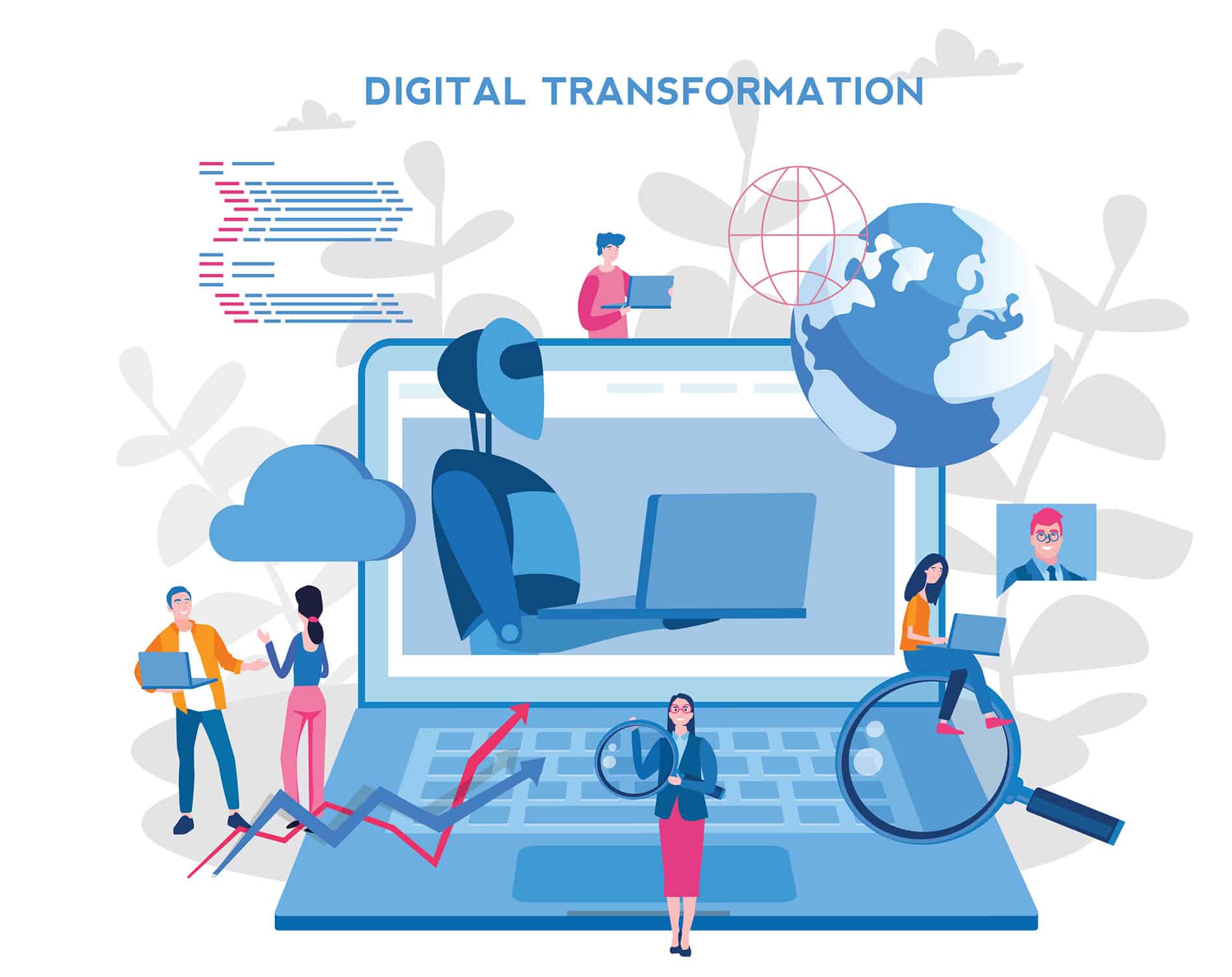CIOs often face numerous challenges while undergoing digital transformation within their organizations.
According to Gartner, digital transformation refers to anything from IT modernization to digital optimization, to the invention of new digital business models.
For many, digital transformation refers to the integration of digital technology into all areas of a business or organization, resulting in fundamental changes to how the organization operates and delivers value to its customers.
In this blog post, we will outline the various obstacles CIOs encounter, share practical tips and best practices and discuss the importance of collaboration and innovation in driving success.
Identifying the Challenges of Digital Transformation
As organizations start their digital transformation journey, it’s not uncommon to encounter obstacles. These often include:
- Lack of technical expertise: Many teams initially struggle with understanding and implementing new technologies and processes – this is especially true for groups outside of IT that might not have as many technical resources.
- Organizational resistance to change: Many employees can be hesitant to embrace new ways of working and fear potential job loss as new processes and automations are introduced.
- Resource constraints: It’s not uncommon for many businesses and organizations to have limited financial resources and staff to execute digital transformations effectively.
- Lack of clear vision and a roadmap: Another common obstacle many teams experience is difficulty in defining the end goal and prioritizing initiatives as there can be many different pieces to digital transformation.
Overcoming Digital Transformation Obstacles
To address these challenges, organizations can use the following steps:
- Develop a clear vision and roadmap: Start by identifying your organization’s digital transformation goals and establish a detailed roadmap to achieve them. This will help you align technology decisions with business objectives and prioritize projects accordingly for every department looking to upgrade its processes and technology.
- Upskill and reskill employees: If you are facing a shortage of technical expertise to execute your roadmap, you can invest in training programs to enhance your team’s technical expertise and adaptability to new technologies. In addition, you can look at investing in low-code/no-code technologies with robust service and support capabilities – this can empower more employees to use the technologies and vendors that excel at implementation services can help to train your resources on the new tech.
- Build a culture of innovation: Encourage experimentation and collaboration by creating cross-functional teams and providing a safe environment for employees to test new ideas as all of these new technologies and processes are implemented.
- Secure executive buy-in: Be sure to engage with top management across departments to gain their support and commitment to the digital transformation journey.
- Leverage external partnerships: Collaborate and lean on your technology partners and vendors to access specialized knowledge and resources. They can be the best resources when it comes to guidance and best practices.
Practical Tips and Best Practices
In addition to the tips above, when embarking on a digital transformation journey we recommend you do the following to set your company up for success:
- Emphasize communication and transparency: Keep employees informed about the rationale, objectives and progress of the transformation to minimize resistance and foster engagement.
- Adopt an agile approach: Implement iterative processes and adopt a flexible mindset to adapt to changing circumstances and learn from mistakes.
- Prioritize employee experience: Design new processes and systems with user-friendliness in mind to facilitate better adoption and maximize productivity.
Once departments see the value in digital transformation, they are more likely to adapt to the new processes and technology being implemented.
At AgSouth Farm Credit, an agricultural lending cooperative serving 147 rural counties across the Carolinas and Georgia, digital transformation has resulted in faster resolution times for end-users and enhanced regulatory compliance.
Headquartered in Statesville, North Carolina, the financial services organization is driven by top customer service and employee engagement, while meeting strict federal compliance standards. Its Business Solutions and IT service teams must deliver timely and effective service to employees and customers — as a failure to do so would be costly for the business, from dollars to an equally costly lack of efficiency/performance.
“AgSouth provides loans to farmers, families and rural communities in our tri-state footprint. The types of loans that we offer are overseen by several regulators,” Rebecca Wood, Director of Business Solutions, explained. “If during the loan process, we answer a question incorrectly or miss a key deliverable date, not only could we be fined, but we could also impact the financial needs of the end customers that we serve.”
The regulations that AgSouth faces are typical for the financial industry. “We have to be able to provide loan decisions or disclosures within a certain number of days,” Wood said. “There are many timelines that are set in stone, and if you miss those, you not only could be fined, but you could also impact your customer’s closing date and damage the reputation of our strong organization.” So, if an employee has a question on how to do a task or is having trouble logging into a particular software program, they need the issue resolved promptly.
Using the TeamDynamix platform for IT and enterprise service management helps Wood and her colleagues provide fast and reliable service in support of organizational goals. Since moving to TeamDynamix, the Business Solutions and IT teams have not only improved their response times in answering peoples’ questions and resolving IT issues, but they have also standardized the quality and consistency of responses that employees receive. The platform also helps AgSouth team members manage complex projects which include many moving pieces and multidepartment engagement requirements.
“TeamDynamix has been a game changer for us in making sure we’re providing the kind of timely, exceptional service that’s needed to support a large employee base from our relatively small department,” Wood said.
Leveraging Technology Solutions
To support digital transformation efforts, you can utilize specific tools that can help you achieve your goals, just as AgSouth has done. Some of those tools can include the following for IT:
- iPaaS (Integration Platform as a Service): iPaaS is a cloud-based platform that enables businesses to integrate different systems and applications, both cloud-based and on-premises, using pre-built connectors and APIs. By leveraging iPaaS, businesses can more easily connect their various systems and data sources, which can help improve operational efficiency, enhance customer experiences and drive innovation. For example, iPaaS can be used to integrate a company’s e-commerce platform with its back-end inventory management system, enabling real-time inventory tracking and order fulfillment.
- Codeless Enterprise Service/IT Service Management software: Codeless ITSM/ESM tools can allow you to automate repetitive tasks and improve service delivery without the need for custom coding – this saves you time and resources.
Together, iPaaS and ITSM/ESM platforms can help you drive digital transformation by enabling your company to:
- Integrate and streamline various systems and data sources, both within IT and across the business as a whole.
- Automate processes and workflows, reducing the need for manual intervention and improving operational efficiency.
- Enhance collaboration and communication between IT and your business, improving alignment and driving innovation.
- Improve service delivery and customer experiences by ensuring that IT resources are properly aligned with business objectives.
Ultimately, iPaaS and ITSM/ESM platforms are two key components of a digital transformation strategy, helping you to connect various systems and data sources, streamline your IT operations and deliver more value to your customers.
The Importance of Collaboration and Innovation
A successful digital transformation requires collaboration among all stakeholders, including employees, management and external partners/technology vendors.
By fostering a culture of innovation and embracing change, organizations can overcome the challenges of digital transformation and thrive in an increasingly competitive landscape.
In conclusion, navigating the challenges of digital transformation is not an easy task, but with a clear vision, roadmap and the right strategies in place, organizations can successfully embrace change and drive business growth.

